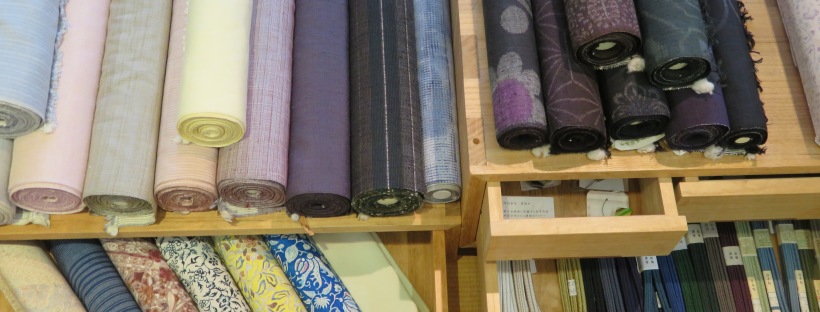This article in All About Japan explains Japan's handicraft of homespun silk and how what was once the only silk fabric permitted to commoners has become a highly desirable luxury folk craft. (Archived article originally published in All About Japan)
Category: Kanto
Symbolic Soba for the New Year
My friend Etsuo recently suggested that we get together for dinner at Sunaba, one of his favorite soba restaurants. "We can have toshi-koshi soba," he exclaimed, excitedly. Ah, yes! Toshi-koshi soba, a serving of buckwheat noodles eaten at the end of the year. The noodles are symbolic in a couple of different ways. Soba noodles, … Continue reading Symbolic Soba for the New Year
Miyashita Park: green space in the sky
Ghibli may have created an animation of Castles in the Sky, but Tokyo's Shibuya Ward has created a real-life park in the sky. Miyashita Park was once a rather forlorn little playground park wedged between Meiji-dori and the Yamanote train line, just north of Mitake-dori (ie, a few hundred meters north of Shibuya station). The … Continue reading Miyashita Park: green space in the sky
The Nihonbashi Seven Lucky Gods Walk: An exploration steeped in history and tradition
Seven Lucky Gods walks are a popular new year's activity and this Japan Today article is published just in time for readers in Tokyo to use it in the coming new year period. (Note, there's a list of other walks at the end, too.) Since the article does not include a dynamic map, one is … Continue reading The Nihonbashi Seven Lucky Gods Walk: An exploration steeped in history and tradition
Sushi: Breakfast of Champions!
An early morning visit to the largest seafood market in the world is still high on the must-do lists of many visitors to Tokyo, even after the market moved to its new location in Toyosu a few years ago. A visit to the Toyosu Seafood Market is more “sanitized” than one to its predecessor, Tsukiji--at … Continue reading Sushi: Breakfast of Champions!
The Centenary of Frank Lloyd Wright’s Imperial Hotel
One hundred years ago, on September 1, 1923, Tokyo was hit by a M7.9 earthquake that badly damaged the city. Because the quake struck just as mid-day meals were being prepared across the city, fires broke out across the city causing even further (some say even more serious) damage. Altogether, between 100,000 and 150,000 lives … Continue reading The Centenary of Frank Lloyd Wright’s Imperial Hotel
Yoyogi Hachiman Shrine: sacred hilltop with prehistoric roots
Yoyogi Hachiman Shrine sits on a small wooded hill next to Yamate-dori, one of Tokyo's famed ring roads, just a short walk from Yoyogi Park and an even shorter walk from the shrine's namesake train station on the Odakyu Line. The shrine was founded in 1212, dedicated to Hachiman, a deification of the Emperor Ojin … Continue reading Yoyogi Hachiman Shrine: sacred hilltop with prehistoric roots
Kasama: abundant azaleas (and other delights)
Ibaraki's Kasama is a bit of a hidden treasure. Just a couple of hours from Tokyo, it is relatively unknown by foreign tourists, and even by most Japanese. Yet it offers many interesting sights and activities, especially at this time of year. Kasama hosts an annual azalea festival from mid-April to early May (in 2023, … Continue reading Kasama: abundant azaleas (and other delights)
The new digital exhibition at the Gallery of Horyuji Treasures: A modern way to explore the art of ancient Japan
This article in Japan Today introduces the Gallery of Horyuji Treasures at the Tokyo National Museum, a little known gallery with lots to offer, including a new digital gallery. (Archived article published in Japan Today.)
The Sakura Seven: A walk to gain good fortune
Every December my Japan Today article details a different seven lucky gods walk, allowing my readers in the vicinity to enjoy the walk and pick up some luck for the new year. This December it's a walk in Chiba, about an hour out of Tokyo. All the best for 2023, everyone! (Archived article from Japan … Continue reading The Sakura Seven: A walk to gain good fortune
Zojoji’s Sanmon: A Rare Look at a Gateway of Antiquities
Zojiji Temple in Tokyo's Shiba neighborhood was once considered a guardian of the southwest entry to Edo (the old name for Tokyo). Visitors approaching the city via the Tokaido Road would have passed nearby and would, inevitably, have seen the massive awe-inspiring structures of the expansive temple complex, which was a seminary and center of … Continue reading Zojoji’s Sanmon: A Rare Look at a Gateway of Antiquities
Celebrating 150 years of railroads in Japan
On October 14, 1872, Japan's first passenger rail service opened, running between Yokohama (near modern-day Sakuragicho Station) and Tokyo (near modern-day Shimbashi Station). Such a milestone deserves celebration, especially one observing a service that has, in large degree, molded a nation. Certainly JR East agrees, so that Tokyo, at least, is widely decorated with posters … Continue reading Celebrating 150 years of railroads in Japan











